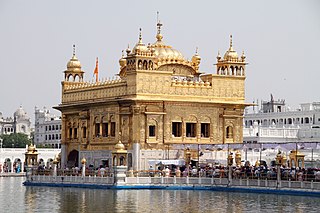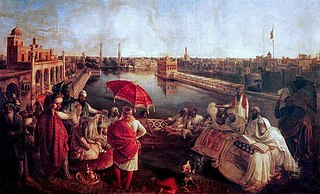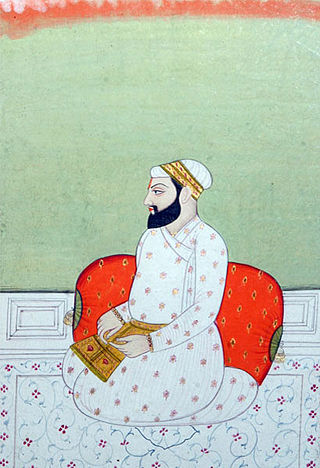| |||||
| Centuries: | |||||
|---|---|---|---|---|---|
| Decades: | |||||
| See also: | List of years in India Timeline of Indian history | ||||
Events in the year 1606 in India.
| |||||
| Centuries: | |||||
|---|---|---|---|---|---|
| Decades: | |||||
| See also: | List of years in India Timeline of Indian history | ||||
Events in the year 1606 in India.

Sikhism, also known as Sikhi, is an Indian religion and philosophy that originated in the Punjab region of the Indian subcontinent around the end of the 15th century CE. It is one of the most recently founded major religious groups and among the largest in the world with about 25–30 million adherents.

Sikhs are an ethnoreligious group who adhere to Sikhism, a religion that originated in the late 15th century in the Punjab region of the Indian subcontinent, based on the revelation of Guru Nanak. The term Sikh has its origin in the Sanskrit word śiṣya, meaning 'seeker', 'disciple' or 'student'.

A gurdwara or gurudwara is a place of assembly and worship for Sikhs but its normal meaning is place of guru or "Home of guru". Sikhs also refer to gurdwaras as Gurdwara Sahib. People from all faiths and religions are welcomed in gurdwaras. Each gurdwara has a Darbar Sahib where the Guru Granth Sahib is placed on a takht in a prominent central position. Any congregant may recite, sing, and explain the verses from the Guru Granth Sahib, in the presence of the rest of the congregation.

Guru Gobind Singh was the tenth and last human Sikh Guru. He was a warrior, poet, and philosopher. In 1675, at the age of nine he was formally installed as the leader of the Sikhs after his father Guru Tegh Bahadur was executed by Emperor Aurangzeb. His father was the ninth Sikh Guru. His four biological sons died during his lifetime – two in battle and two executed by the Mughal governor Wazir Khan.

The Guru Granth Sahib is the central holy religious scripture of Sikhism, regarded by Sikhs as the final, sovereign and eternal Guru following the lineage of the ten human gurus of the religion. The Adi Granth, its first rendition, was compiled by the fifth guru, Guru Arjan (1564–1606). Its compilation was completed on 29 August 1604 and first installed inside the Golden Temple in Amritsar on 1 September 1604. Baba Buddha was appointed the first Granthi of the Golden Temple. Shortly afterwards Guru Hargobind added Ramkali Ki Vaar. Later, Guru Gobind Singh, the tenth Sikh guru, added hymns of Guru Tegh Bahadur to the Adi Granth and affirmed the text as his successor. This second rendition became known as the Guru Granth Sahib and is also sometimes referred to as the Adi Granth.

The term Khalsa refers to both a community that considers Sikhism as its faith, as well as a special group of initiated Sikhs. The Khalsa tradition was initiated in 1699 by the Tenth Guru of Sikhism, Guru Gobind Singh. Its formation was a key event in the history of Sikhism. The founding of Khalsa is celebrated by Sikhs during the festival of Vaisakhi.

Guru Tegh Bahadur was the ninth of ten gurus who founded the Sikh religion and was the leader of Sikhs from 1665 until his beheading in 1675. He was born in Amritsar, Punjab, India in 1621 and was the youngest son of Guru Hargobind, the sixth Sikh guru. Considered a principled and fearless warrior, he was a learned spiritual scholar and a poet whose 115 hymns are included in the Guru Granth Sahib, which is the main text of Sikhism.

The Sikh gurus are the spiritual masters of Sikhism, who established the religion over the course of about two and a half centuries, beginning in 1469. The year 1469 marks the birth of Guru Nanak, the founder of Sikhism. He was succeeded by nine other human gurus until, in 1708, the Guruship was finally passed on by the tenth guru to the holy Sikh scripture, Guru Granth Sahib, which is now considered the living Guru by the followers of the Sikh faith.
Hinduism and Sikhism are Indian religions. Hinduism has pre-historic origins, while Sikhism was founded in the 15th century by Guru Nanak. Both religions share many philosophical concepts such as karma, dharma, mukti, and maya although both religions have different interpretation of some of these concepts.
Guru Nanak founded the Sikh religion in the Punjab region of the northern part of the Indian subcontinent in the 15th century and opposed many traditional practices like fasting, Upanayana, idolatry, caste system, ascetism, azan, economic materialism, and gender discrimination.
The principles of Sikhism state that women have the same souls as men and thus possess an equal right to cultivate their spirituality with equal chances of achieving salvation. Women participate in all Sikh religious, cultural, social, and secular activities including lead religious congregations, take part in the Akhand Path, perform Kirtan, perform Gatka and work as a Granthis.

Religion in India is characterised by a diversity of religious beliefs and practices. Throughout India's history, religion has been an important part of the country's culture and the Indian subcontinent is the birthplace of four of the world's major religions, namely, Buddhism, Hinduism, Jainism, and Sikhism, which are collectively known as native Indian religions or Dharmic religions and represent approx. 83% of the total population of India.

Bandi Chhor Divas is a Sikh celebration commemorating the day the sixth Guru of Sikhs, Guru Hargobind and 52 Hindu Kings were released from Gwalior Fort, who had been imprisoned by Mughal Emperor Jahangir. Emperor Jahangir had held 52 Kings at the Gwalior Fort for several months. Gurdwara Data Bandi Chhor Sahib is located at the place of the Guru's internment in the Fort. The day falls in autumn and often overlaps with Hindu Diwali, the festival of lights celebrated across Punjab and the rest of India. Historically, from the time of the third Sikh Guru Amar Das, Sikhs and Hindus of the time used the occasion of Diwali, Vaisakhi and other such festivals to congregate at the seat of the Gurus. In 2003, Sikh religious leaders and the Shiromani Gurdwara Parbandhak Committee led by Prof. Kirpal Singh Badungar formally adopted this day into the Nanakshahi calendar.

Gurū Nānak, also known as Bābā Nānak, was the founder of Sikhism and is the first of the ten Sikh Gurus. His birth is celebrated as Guru Nanak Gurpurab on Katak Pooranmashi, i.e. October–November.

The Golden Temple (also known as the Harmandir Sahib, or the Darbār Sahib, is a gurdwara located in the city of Amritsar, Punjab, India. It is the pre-eminent spiritual site of Sikhism. It is one of the holiest sites in Sikhism, alongside the Gurdwara Darbar Sahib Kartarpur in Kartarpur, and Gurdwara Janam Asthan in Nankana Sahib.
A takht, or taḵẖat, literally means a throne or seat of authority and is a spiritual and temporal centre of Sikhism. There are five takhts, which are five gurudwaras that have a very special significance for the Sikh community. Three are located in Punjab whilst the remaining two are located outside of it.
Events from the year 1535 in India.
Events from the year 1598 in India.

Guru Arjan was the fifth of the ten total Sikh Gurus. He compiled the first official edition of the Sikh scripture called the Adi Granth, which later expanded into the Guru Granth Sahib. He is regarded as the first of the two Gurus martyred in the Sikh faith.

Jagtar Singh Grewal was an Indian writer, historian, scholar, and a vice-chancellor of the Guru Nanak Dev University (GNDU).